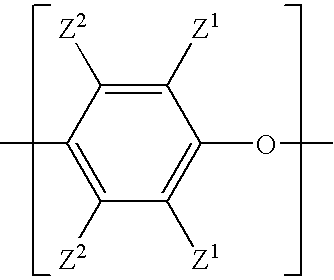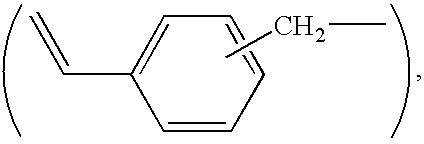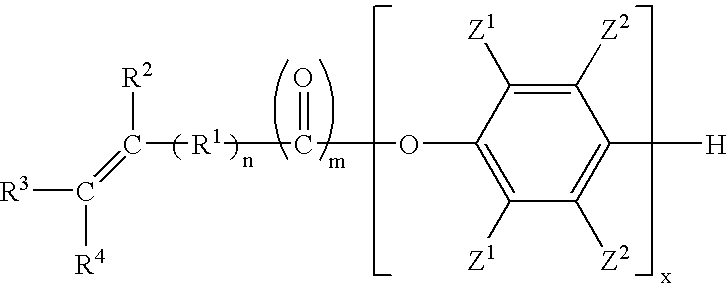Method of forming a crosslinked poly(arylene ether) film, and film formed thereby
a crosslinked poly(arylene ether) and film technology, applied in the field of microelectronics, can solve the problems of reducing the reliability of data transport, increasing the delay of signal, and comparatively reducing the heat resistan
- Summary
- Abstract
- Description
- Claims
- Application Information
AI Technical Summary
Benefits of technology
Problems solved by technology
Method used
Image
Examples
examples 1-4
[0039]Four poly(arylene ether) copolymers, designated “APPExx” where the numbered suffix represents the weight percent of 2-allyl-6-methylphenol in the monomer mixture (for example, “APPE10” refers to a copolymer prepared from monomer comprising 10 weight percent), were prepared by oxidative copolymerization of 2,6-dimethylphenol and 2-allyl-6-methylphenol using the following procedure. Nitrogen was flowed through a reactor maintained at 25° C. A monomer solution (3.4 kilograms) containing 50 weight percent toluene and 50 weight percent total of 2,6-dimethylphenol and 2-allyl-6-methylphenol was transferred to an addition vessel attached to the reactor. The reactor was charged with 7.5 weight percent of the monomer solution, di-n-butylamine (10 grams), dimethyl-n-butylamine (23.5 grams), oleyltrimethylammonium chloride (1 gram), N,N′-di-t-butylethylenediamine (1.5 grams), and an aqueous solution (7.5 grams) containing 6.5 weight percent copper (as Cu2O) and 48 weight percent hydrobro...
examples 5-17
[0044]In these examples, crosslinked films are prepared by treating uncrosslinked films with accelerated electrons. A poly(arylene ether) homopolymer, poly(2,6-dimethyl-1,4-phenylene ether), having an intrinsic viscosity of 0.46 deciliter per gram measured in chloroform at 25° C. was obtained as PPO* 646 from GE Plastics. This poly(arylene ether) homopolymer is designated “PPE” in Table 3. An apparatus suitable for electron beam crosslinking is the Application Development Unit available from Advanced Electron Beam Inc. The electrons may be accelerated through about 80 to about 150 kilovolts (kV). The depth of penetration without any attenuation of dosage for a unit density is about 80 micrometers under these conditions. When, for example, the films are about 40 micrometers thick and have a specific gravity of about 1.08 grams per milliliter, the electron beam fully penetrates the film without any significant lowering of dosage. The single pass dosage is up to 75 kiloGrays and total ...
examples 18-25
[0050]Two poly(arylene ether) compositions were prepared by mixing a poly(arylene ether) copolymer and an olefinically unsaturated monomer in chloroform. Table 5 shows their compositions. Two olefinically unsaturated monomers were used: diallyl phthalate (“DAP” in Table 5), and triallyl isocyanurate (“TAIC” in Table 5).
[0051]The films were prepared using the procedure described for Examples 5-17. The films were then subjected to the varying dosages of electron beam, and gel content and percent allyl crosslinking were determined. The results are summarized in Table 5.
[0052]A comparison of the gel content values presented in Table 5 with those in Table 4 indicates that the use of olefinically unsaturated monomer has a fairly small effect on the gel content of the cured films (for example, gel contents of 77.3% (with diallyl phthalate) and 77.7% (without diallyl phthalate) at 1200 kiloGrays irradiation of the APPE15 samples; 93.5% (with diallyl phthalate) and 91.8% (without diallyl pht...
PUM
| Property | Measurement | Unit |
|---|---|---|
| Temperature | aaaaa | aaaaa |
| Fraction | aaaaa | aaaaa |
| Percent by mass | aaaaa | aaaaa |
Abstract
Description
Claims
Application Information
 Login to View More
Login to View More - R&D
- Intellectual Property
- Life Sciences
- Materials
- Tech Scout
- Unparalleled Data Quality
- Higher Quality Content
- 60% Fewer Hallucinations
Browse by: Latest US Patents, China's latest patents, Technical Efficacy Thesaurus, Application Domain, Technology Topic, Popular Technical Reports.
© 2025 PatSnap. All rights reserved.Legal|Privacy policy|Modern Slavery Act Transparency Statement|Sitemap|About US| Contact US: help@patsnap.com



